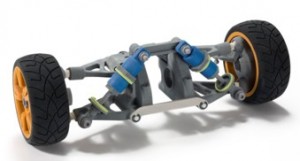Are you using zp® 150 performance composite in your 3D printer? Zp® 150 material is necessary for any solid print, as it is the best powder system available. It is best to have zp® 150 performance composite set as the default powder on your system. No more choosing between powders, the zp® 150 does it all.
It is 90% whiter than zp 131, has a 125% larger color gamut than zp 131, and has highest green strength available. Green strength is the solidity, substance, and sturdiness of a part right out of the printer before any infiltrant is applied. It is now possible to create and print multifaceted parts with complex details that require the highest strength.
Parts with many intricate and tiny pieces, such as the axles pictured above, require the most powerful composite to hold it all together. The model’s green strength should be robust and stand on it’s own, and this is possible with zp®150 material.
With better color and whiteness of any previous materials used, it creates stronger models with better-looking final results. Using zp® 150 allows for a user-friendly, and shorter post-processing time as most parts can be removed right after the drying cycle is completed.


